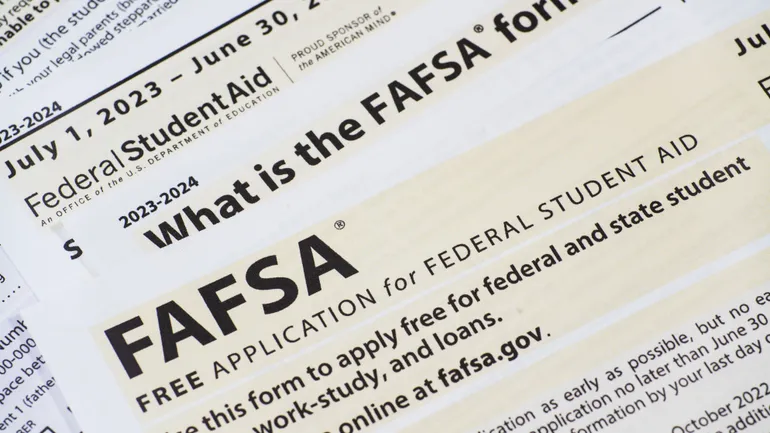Dive Brief:
- The number of students completing the Free Application for Federal Student Aid is inching closer to 2023 levels, according to the latest analysis from the National College Attainment Network. As of May 17, some 41.5% of the class of 2024 — about 1.7 million students — have submitted the revamped form.
- That’s still down 15.5% from the same time last year, when over 2 million students had completed the FAFSA. But the gap has narrowed from the end of March, when this year’s submissions lagged by 27.1%.
- Higher education experts and policy advocates are now lobbying federal lawmakers to ensure that FAFSA’s woes, and the ensuing completion gap, do not continue into the next admissions cycle.
Dive Insight:
The U.S. Department of Education unveiled a simplified version of the FAFSA in late December, about three months after the typical release date. The new form streamlines the process for students and their families, asking several dozen questions at most compared to up to 100 in the original.
But the process has been plagued by technical glitches and formula errors, on top of the initial delay.
The ensuing chaos caused ripple effects, as colleges and states often use the FAFSA — which acts as a gateway to federal student aid — to guide their own aid distribution.
In early May, West Virginia declared a state of emergency to temporarily allow high school students to qualify for its biggest college financial aid programs without completing the FAFSA. The state has one of the most significant gaps in year-over-year FAFSA completion, lagging by 23% according to NCAN.
The delays also caused many higher education institutions to push back their commitment deadlines for students from the traditional May 1.
While this year’s FAFSA completion rate has continued to rise in recent weeks, it’s unlikely to reach 2023’s level, said Elizabeth Morgan, NCAN’s chief external relations officer.
“We’ve been catching up at a pretty good clip,” she said. “But gains of 2% or more per week are probably not going to sustain through June.”
Since the updated form’s troubled rollout, the Education Department has announced a handful of FAFSA support strategies for colleges, high schools and higher ed organizations aimed at boosting the rate of student completion.
Its latest, the $50 million FAFSA Student Support Strategy program, has funded over 65 groups to encourage form completion since its launch early in May, the agency said Friday.
Morgan said the program will let many NCAN-affiliated organizations to continue helping students complete forms into the summer — something they planned on doing, but lacked support for.
“I talked to several NCAN members a couple of months ago who said, ‘I’m hiring more help this summer. I don’t know how I’m going to pay for it yet. But I’m going to do that,'” she said.
Given this mindset, organizations already had a plan in place when the program opened, allowing them to apply quickly, Morgan said.
Meanwhile, many college experts are already turning their eyes to the 2024-25 application cycle.
In a May 22 letter, three dozen higher education organizations, led by the American Council on Education, urged lawmakers to take action to safeguard the next FAFSA cycle from similar delays.
The groups asked the House and Senate education committees to assess and publicize the changes made to the FAFSA formula for student need and to formalize the traditional Oct. 1 deadline for the form’s release.
In addition, they called on Congress to evaluate and share how the FAFSA delays have affected colleges and students, especially students from low-income families.
“We also ask that should any proposal suggested in this letter be implemented, that its implementation be done in a manner that does not create any future FAFSA delay,” wrote Ted Mitchell, president of ACE.
A policy expert at the National Association of Student Financial Aid Administrators — one of the letter’s signatories — said timely release of the FAFSA moving forward will be crucial to ensuring colleges have enough time to make financial aid offers and students and families have the time to weigh them.
“I am reasonably optimistic that there is support in Congress,” said Karen McCarthy, NASFAA’s vice president of public policy and federal relations. “I am less optimistic that it will actually make its way into legislation that passes before Oct.1 of this coming year.”
McCarthy said the need for an Oct. 1 release date supersedes many of the letter’s requests for now.
“If Congress were to pass something in July requiring a particular change, that would be a very heavy lift for the Department of Education to implement. We would not want Congress to require that the department implement it for the ’25-’26 year,” she said.
Even without legislation, Education Department officials have given every indication they expect the form to open this year at the start of October, Morgan said. She agreed that a prompt rollout will be pivotal to the next admissions cycle’s success.
“Opening the FAFSA — even as it exists right now — by Oct.1 would still be a big improvement over this year,” Morgan said.
#FAFSA #completion #gap #shrinking #disappear










